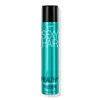What's inside
What's inside
 Benefits
Benefits

No benefits
 Concerns
Concerns

 Ingredients Side-by-side
Ingredients Side-by-side

Sd Alcohol 40
AstringentHydrofluorocarbon 152a
Octylacrylamide/Acrylates/Butylaminoethyl Methacrylate Copolymer
Aminomethyl Propanol
BufferingCyclopentasiloxane
EmollientCyclotetrasiloxane
EmollientPEG/PPG-17/18 Dimethicone
EmulsifyingTriethyl Citrate
MaskingParfum
MaskingBenzyl Salicylate
PerfumingButylphenyl Methylpropional
PerfumingCitronellol
PerfumingHydroxycitronellal
PerfumingLimonene
PerfumingLinalool
PerfumingPentaerythrityl Tetracaprylate/Tetracaprate
EmollientAmp-Isostearoyl Hydrolyzed Wheat Protein
CleansingPhenyl Trimethicone
Skin ConditioningEthylhexyl Methoxycinnamate
UV AbsorberSd Alcohol 40, Hydrofluorocarbon 152a, Octylacrylamide/Acrylates/Butylaminoethyl Methacrylate Copolymer, Aminomethyl Propanol, Cyclopentasiloxane, Cyclotetrasiloxane, PEG/PPG-17/18 Dimethicone, Triethyl Citrate, Parfum, Benzyl Salicylate, Butylphenyl Methylpropional, Citronellol, Hydroxycitronellal, Limonene, Linalool, Pentaerythrityl Tetracaprylate/Tetracaprate, Amp-Isostearoyl Hydrolyzed Wheat Protein, Phenyl Trimethicone, Ethylhexyl Methoxycinnamate
Alcohol Denat.
AntimicrobialHydrofluorocarbon 152a
Isobutane
Octylacrylamide/Acrylates/Butylaminoethyl Methacrylate Copolymer
Aminomethyl Propanol
BufferingCyclopentasiloxane
EmollientWater
Skin ConditioningAmp-Isostearoyl Hydrolyzed Wheat Protein
CleansingParfum
MaskingPEG-12 Dimethicone
Skin ConditioningPhenyl Trimethicone
Skin ConditioningTriethyl Citrate
MaskingBenzophenone-3
UV AbsorberVa/Crotonates/Vinyl Neodecanoate Copolymer
PPG-12 Dimethicone
Skin ConditioningAcacia Dealbata Flower Extract
Skin ConditioningMoonstone Powder
Skin ConditioningCalcium Stearate
Cosmetic ColorantPerfluorononyl Dimethicone
Skin ConditioningPropylene Glycol
HumectantQuaternium-70
Keratin
Skin ConditioningHydrolyzed Keratin
HumectantPhenoxyethanol
PreservativeLimonene
PerfumingLinalool
PerfumingAlcohol Denat., Hydrofluorocarbon 152a, Isobutane, Octylacrylamide/Acrylates/Butylaminoethyl Methacrylate Copolymer, Aminomethyl Propanol, Cyclopentasiloxane, Water, Amp-Isostearoyl Hydrolyzed Wheat Protein, Parfum, PEG-12 Dimethicone, Phenyl Trimethicone, Triethyl Citrate, Benzophenone-3, Va/Crotonates/Vinyl Neodecanoate Copolymer, PPG-12 Dimethicone, Acacia Dealbata Flower Extract, Moonstone Powder, Calcium Stearate, Perfluorononyl Dimethicone, Propylene Glycol, Quaternium-70, Keratin, Hydrolyzed Keratin, Phenoxyethanol, Limonene, Linalool
Ingredients Explained
These ingredients are found in both products.
Ingredients higher up in an ingredient list are typically present in a larger amount.
Aminomethyl Propanol is used to adjust the pH of products. It is also used as a base to create other organic compounds. Having a balanced pH is important for protecting your skin.
Aminomethyl propanol is safe to use in cosmetics up to 1%. It is soluble in water.
We don't have a description for Amp-Isostearoyl Hydrolyzed Wheat Protein yet.
Cyclopentasiloxane, or D5, is a silicone used to improve texture of products and trap moisture.
D5 is considered lightweight and volatile. Volatile means it evaporates quickly after application. Once evaporated, D5 leaves a thin barrier that helps keep skin hydrated.
It is also an emollient. Emollients help soften the skin and prevent water loss. Silicones create a silky texture in products. D5 helps other ingredients become more spreadable.
Studies show D5 is safe to use in skincare products. We recommend speaking with a skincare professional if you have concerns.
Learn more about CyclopentasiloxaneWe don't have a description for Hydrofluorocarbon 152a yet.
Limonene is a fragrance that adds scent and taste to a formulation.
It's found in the peel oil of citrus fruits and other plants such as lavender and eucalyptus. The scent of limonene is generally described as "sweet citrus".
Limonene acts as an antioxidant, meaning it helps neutralize free radicals.
When exposed to air, oxidized limonene may sensitize the skin. Because of this, limonene is often avoided by people with sensitive skin.
The term 'fragrance' is not regulated in many countries. In many cases, it is up to the brand to define this term. For instance, many brands choose to label themselves as "fragrance-free" because they are not using synthetic fragrances. However, their products may still contain ingredients such as essential oils that are considered a fragrance.
Learn more about LimoneneLinalool is a fragrance and helps add scent to products. It's derived from common plants such as cinnamon, mint, citrus, and lavender.
Like Limonene, this ingredient oxidizes when exposed to air. Oxidized linalool can cause allergies and skin sensitivity.
This ingredient has a scent that is floral, spicy tropical, and citrus-like.
Learn more about LinaloolWe don't have a description for Octylacrylamide/Acrylates/Butylaminoethyl Methacrylate Copolymer yet.
Parfum is a catch-all term for an ingredient or more that is used to give a scent to products.
Also called "fragrance", this ingredient can be a blend of hundreds of chemicals or plant oils. This means every product with "fragrance" or "parfum" in the ingredients list is a different mixture.
For instance, Habanolide is a proprietary trade name for a specific aroma chemical. When used as a fragrance ingredient in cosmetics, most aroma chemicals fall under the broad labeling category of “FRAGRANCE” or “PARFUM” according to EU and US regulations.
The term 'parfum' or 'fragrance' is not regulated in many countries. In many cases, it is up to the brand to define this term.
For instance, many brands choose to label themselves as "fragrance-free" because they are not using synthetic fragrances. However, their products may still contain ingredients such as essential oils that are considered a fragrance by INCI standards.
One example is Calendula flower extract. Calendula is an essential oil that still imparts a scent or 'fragrance'.
Depending on the blend, the ingredients in the mixture can cause allergies and sensitivities on the skin. Some ingredients that are known EU allergens include linalool and citronellol.
Parfum can also be used to mask or cover an unpleasant scent.
The bottom line is: not all fragrances/parfum/ingredients are created equally. If you are worried about fragrances, we recommend taking a closer look at an ingredient. And of course, we always recommend speaking with a professional.
Learn more about ParfumPhenyl Trimethicone is a silicon-based polymer. It is derived from silica.
Phenyl Trimethicone is used as an emollient and prevents products from foaming.
As an emollient, it helps trap moisture in the skin. It is considered an occlusive.
Learn more about Phenyl TrimethiconeTriethyl Citrate comes from citric acid. It has masking, perfuming, and solvent properties. As a solvent, this ingredient helps disperse ingredients evenly in skincare.
One manufacturer claims this ingredient can:
According to perfume manufacturers, this ingredient is almost odorless but has a mild fruity, wine and plum scent. It can be used to mask the scent of other ingredients.
This ingredient can be plant-sourced or synthetic; it can naturally be found in cabbage and white wine.
Learn more about Triethyl Citrate